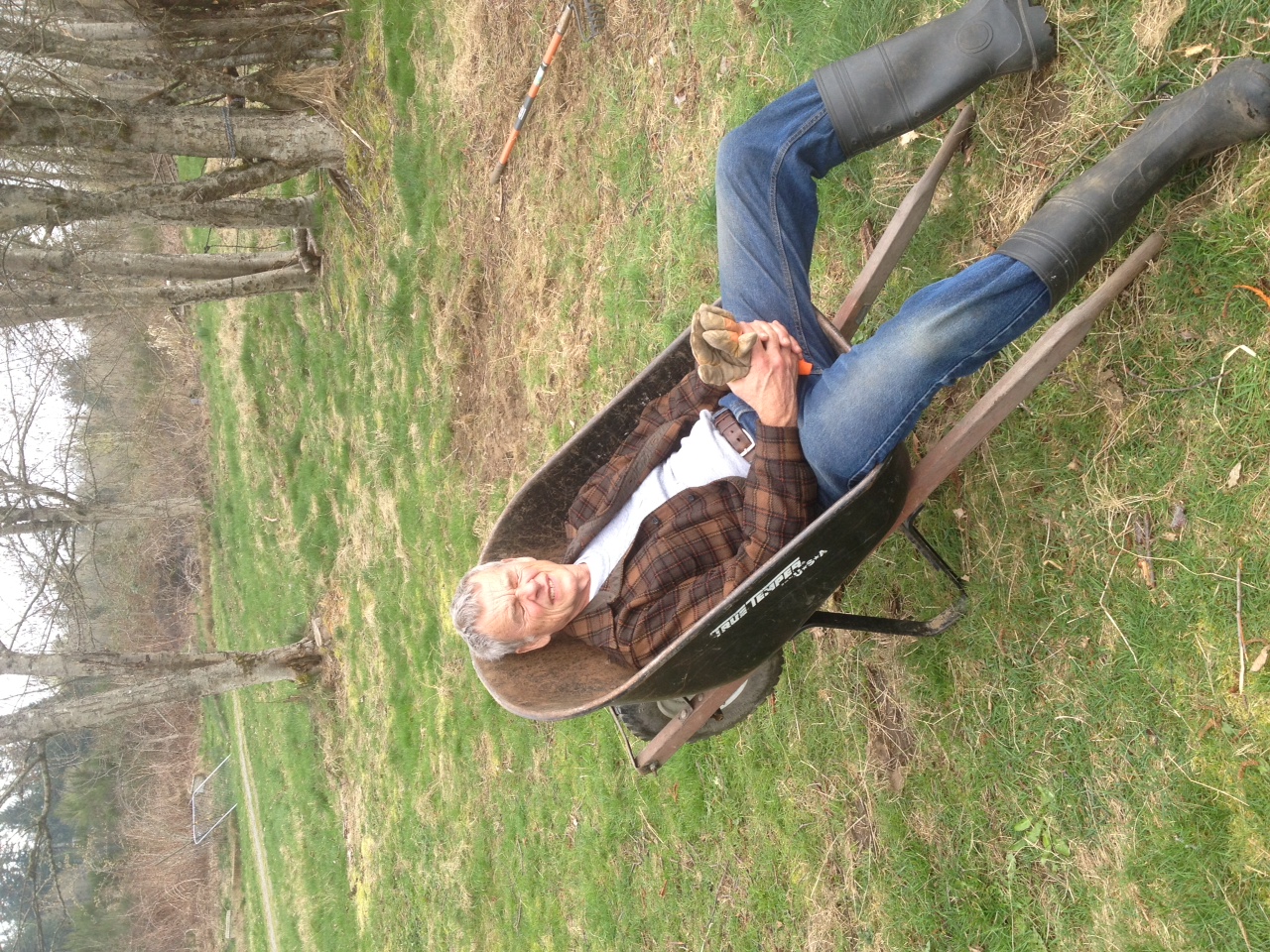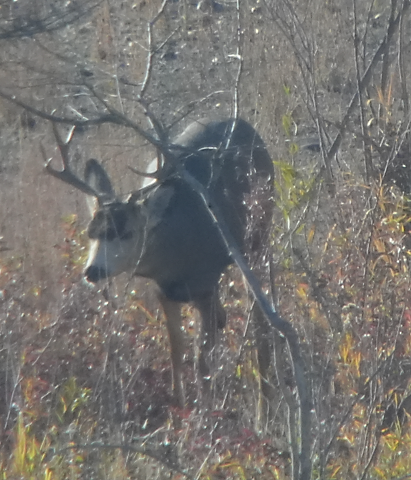Pasco Photo Trip
- Ken Campbell

- Nov 11, 2024
- 6 min read
11 Nov 2024
I just returned from a three-day trip to the Tri-Cities and the house where we used to live on the banks of the Columbia River – call it the CR-House. My goal was to obtain photos of mule deer on the river islands adjacent to the house. These photos were to complement and add to the previous photos I had obtained when we used to live in the CR-house.
The timing of the trip in early November was to catch the early part of the rut when deer begin moving around during mid-day exposing themselves to photo opportunities. Whereas deer are the most active and most exposed for photo taking in late November when the rut is in full swing, taking pictures in the nasty cold and windy weather that often occurs at that time of year can be problematic and downright uncomfortable. I chose early November as a time for my visit because the deer would be moving and exhibiting rut behavior and autumn weather rather than winter weather was still likely to be in play.
I also had a second objective. The distance from the location where the camera needed to be stationed (i.e., on the elevated banks of the river) to the islands where the deer are located is 3/8 of a mile and greater. Without a blind and bait, this is the kind of distance that much of wildlife photography must contend with. It is a game of long-distance photography. To meet this long-distance challenge, I had two camera-lens systems that I wanted to compare. One lens was a high-quality spotting scope with extreme reach; the other lens was a 200-600 mm camera-zoom-lens with a 2X extender. Using the magnification scale to quantify the reach of the lenses, the spotting scope began at 30X and went up from there to 70X; while the camera-zoom-lens with extender topped out at 24X. Despite the high-end optical quality of the spotting scope, the image quality of pictures taken through the spotting scope, although satisfactory for many purposes, did not match the image quality obtained with pictures taken through the 200-600 camera-zoom-lens.
I also had two cameras: a medium high-resolution camera and an ultra-high-resolution camera. Both cameras have excellent reputations and a broad range of functionality. My hope was that the ultra-high-resolution camera could effectively extend the reach of the camera-zoom-lens to match the reach of the spotting scope. Thus, the two photo-systems I wanted to compare were: the medium-high-resolution camera on the spotting scope vs. the ultra-high-resolution camera on the camera-zoom-lens.
My first photo session was on the afternoon of Nov 7 with the medium-high-resolution camera on the spotting scope. I set up the camera system on the shoulder of a gravel road that led to a boat launch. My photo-field was the adjacent Island 19. The afternoon light was adequate but not superb. I located several does and a small-to-medium 4x4 buck bedded in the brush on my side of the island. The deer soon got up and began moving around but remained in the brush. The buck thrashed some of the willows with his antlers but generally kept himself close to the does and in the brush. Over a period of two hours, I took several pictures. The deer never got out of the brush to offer a clear full-body exposure with poses that revealed important identifying details. Some examples from the best pictures that were taken are shown below.
Keep in mind that these images were extracted from photos taken through a spotting scope producing more than 30x optical magnification and then the excerpts from the photos that are shown on this page are magnified approximately another 5X.
I would categorize these photos as suitable as pictures of record, i.e., they document the deer and its identity, but they are not of sufficient quality to show or place in a gallery.
My second photo session was on the morning of Nov 8 using the ultra-high-resolution camera coupled with the camera-zoom-lens. I set up the camera system on a flat spot on a switchback in the gravel trail leading from the CR-house to the boat dock below the house. My photo-field was the adjacent Island 20 just downstream from Island 19. The morning light was fantastic in illuminating the herd of deer that were grazing out in the open area of the island. Among the 20 or so antlerless deer, I soon located a mid-sized 3x3 buck. The deer milled around and remained in the open setting for an extended time. Over a period of two hours, the deer gave me every opportunity to take several pictures. Some examples are shown below. Remember that the optical magnification for these photos was 24X. The image strip shown below represents approximately ¼ of the photo from which it was extracted.

The images below are blowups from photos like the one that gave rise to the above image strip.
These images are more than adequate to plainly reveal signature features of this buck deer and thus, allow unambiguous identification of him. For instance, the 3-point rack with discernable eye guards is clear; the first tine off the main beam is short on the right antler while that tine is long on the left antler; the rack is nearly as wide as the distance between the tips of the ears; the deer possesses a clean well-formed, young-looking face with well-defined dark mahogany forehead; he also has smooth-edge ears (older bucks often display torn, ragged ears); there are well-defined scars behind the right shoulder; and there is a dark mark in the lower part of the white throat-bib.
Through these photos, the buck on Island 20, photographed in the morning of Nov 8, can be clearly distinguished from the buck on Island 19, photographed in the afternoon of Nov 7.
These images are perfectly adequate for the many purposes for which animal images are used such as: documenting the animal’s presence; conveying descriptive information; story telling; etc. Are these quality images? No. A quality image would be one with sufficient character, detail, clarity, composition, depth of field, and background to recommend it going into a gallery or to be put on display for its artistic merit. Animal subjects at 650 meters do not by themselves recommend an artistic creation. To achieve an artistic effect, features of the background and landscape must also be brought into the picture. The images obtained in this photo excursion didn’t rise to that level but they are more than good enough for my purposes which are primarily identification and storytelling.
I had planned a third photo session for the morning of Nov 9 with the medium-high-resolution camera coupled with the camera-zoom-lens. This was to allow me to evaluate just how much the ultra-high-resolution camera contributed to the image quality of these distant subjects. Unfortunately, a thick fog settled on the river overnight and it was impossible to clearly see the islands let alone take photos. I could tell that there were deer on the islands but I was unable to take their pictures.
Conclusion
I concluded from the results of this photo exercise, that long-range picture taking is best done through the camera-zoom-lens rather than the spotting scope even if the reach of the zoom-lens is less than the spotting scope. If the light is good, the ultra-high-resolution camera probably gives slightly better image quality than the medium-high-resolution camera. Under less-than-ideal light conditions, differences in image quality between the two cameras may not be discernible. And, when low-light situations are encountered, the medium-high-resolution camera may actually be the better device.
Where does that leave the spotting scope? I find that the spotting scope is an invaluable adjunct to the long-range photo taking process. The desired photo subject is often difficult to find at a far distance. I have learned that it is best to search for the subject with a pair of binoculars. A suspected find is then confirmed and identified through the spotting scope. And then, the camera system (camera + telephoto zoom lens) is adjusted to put the subject in the camera’s field of view followed by focusing and exposure adjustment.
A second conclusion was that I timed my trip a little too early. I am pretty sure that during my visit there was only one buck on Island 19 and only one buck on Island 20. These were the two mid-sized bucks for which I obtained photos. In years past, I often saw several bucks on each island and the bucks moved from island to island. It is the interaction between bucks during the rut that provides some of the more interesting drama among these deer and I had hoped to see some of this on my current trip. However, in previous years it was always after mid-November when multiple bucks arrived on the islands in numbers. So, this year I beat the herd to the island and thus missed seeing the breeding hierarchy and all the interactions that that produces.
















Comments